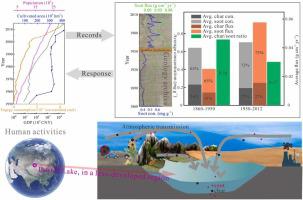当前位置:
X-MOL 学术
›
Anthropocene
›
论文详情
Our official English website, www.x-mol.net, welcomes your feedback! (Note: you will need to create a separate account there.)
Increased black carbon (soot) accumulation during the Anthropocene in a less-developed region of Xinjiang, northwestern China
Anthropocene ( IF 3.6 ) Pub Date : 2024-01-11 , DOI: 10.1016/j.ancene.2024.100425 Dewen Lei , Yongming Han , Changlin Zhan , Chong Wei , Yalan Tang , Meiling Guo , Jianing Zhang , Jingyu Li
Anthropocene ( IF 3.6 ) Pub Date : 2024-01-11 , DOI: 10.1016/j.ancene.2024.100425 Dewen Lei , Yongming Han , Changlin Zhan , Chong Wei , Yalan Tang , Meiling Guo , Jianing Zhang , Jingyu Li

|
Records of environmental changes at regional or continental scales in less-developed regions may aid clarification of the onset of the Anthropocene. A sediment core was collected from Bosten Lake in Xinjiang Province, northwestern China, to investigate historical variations of combustion indicators of black carbon (BC), char and soot and to reflect human influences over the past 150 years. Results show that a rapid increase in soot fluxes (over 1.5 times on average) happened after 1950, consistent with the Great Acceleration period as well as establishment of the People's Republic of China, following a rapidly developing economy. Soot flux peaked around the 1960, coincident with wasteland reclamation in Xinjiang Province, decreasing after the year 2000 owing to environmental protection requirements such as desulfurization. Average char/soot ratios before and after 1950 were 0.56 and 0.37, respectively, such low ratios suggest a predominant contribution of soot from long-range transport, while the industrialization in China since the 1950 s may have caused further reduction in the ratios. Sedimentary soot deposition flux in less-developed areas thus recorded key anthropogenic activities occurring in China and supports the onset of the Anthropocene in the mid-20th century, as proposed by the Anthropocene Working Group.
更新日期:2024-01-11



























 京公网安备 11010802027423号
京公网安备 11010802027423号